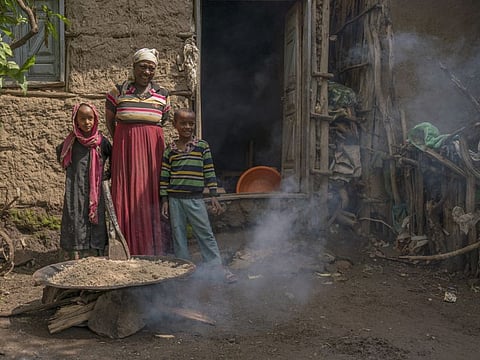Abu Dhabi-led fund gets Dh82.64 million to end neglected tropical diseases
Investment will counter river blindness, lymphatic filariasis

Abu Dhabi: A $22.5 million (Dh82.64 million) investment was announced in the capital on Tuesday to accelerate the treatment and eliminate two neglected tropical diseases (NTDs) in three African countries.
The investment will be provided to the Reaching the Last Mile Fund (RLMF) over three years by the Leona M and Harry B Helmsley Charitable Trust. RLMF is a 10-year multi-donor fund launched by His Highness Sheikh Mohamed Bin Zayed Al Nahyan, Abu Dhabi Crown Prince and Deputy Supreme Commander of the UAE Armed Forces. The US-based foundation’s investment in RLMF was deemed to be ‘a historic’ amount, and it will be used to counter river blindness and lymphatic filariasis in Ethiopia, Sudan and South Sudan, which face a significant portion of global disease burden.
Accelerating treatment
“The Helmsley Charitable Trust is focused on ensuring the wellbeing of vulnerable children and their families in Africa, and we know that building resilience and strengthening health services are critical pathways to achieve this. Through our investment in the RLMF, we are proud to join a network of like-minded investors to accelerate the treatment and elimination of these devastating diseases, and [thus] improve the lives and livelihoods of children and families across Ethiopia and its borders,” Walter Panzirer, a trustee at Helmsley.
“We thank the Helmsley Charitable Trust for their generous investment in the Reaching the Last Mile Fund. We look forward to accelerating progress on ending NTDs with this significant new commitment. Helmsley shares the UAE’s long-held values of helping those in need and empowering people to live healthier and more dignified lives,” said Shaikh Theyab bin Mohamed bin Zayed, chairman of the Abu Dhabi Crown Prince Court.
RLMF action
RLMS is a $100 million (Dh367 million) global partnership between philanthropists, governments, and NGOs that aims to eliminate river blindness and lymphatic filariasis around the world by building on past successes, complementing ongoing efforts, and reducing the diseases’ global footprint. To catalyse faster change, RLMF adopts an approach that encourages active partnership, innovative financing, and the development of new areas of expertise to combat NTDs.
These diseases affect more than 1.7 billion people – often those living in remote, under-resourced communities, and without access to basic needs like clean water. They also contribute to the loss of billions of dollars every year in countries where they are endemic, due to the disability, decreased productivity and caretaker burden they create.
River blindness is caused by a parasite-carrying blackfly. Affected people face severe discomfort, pain and eventual blindness. The disease is the second leading cause of infectious blindness, and 218 million people are at risk, with 99 per cent living in Africa.
Lymphatic filariasis is a parasitic infection transmitted by mosquitoes. Infection is often acquired in childhood, which causes hidden damage to the lymphatic system, and results in painful and profound disfigurement, including elephantiasis and scrotal swelling. More than 850 million people in 50 countries are at risk of lymphatic filariasis.
Progress thus far
Significant progress has been made since the landmark 2012 London Declaration on NTDs, which unified partners across sectors, countries and disease communities to push for greater investment and action. Launched in early 2022, the Kigali Declaration builds upon the goals established by the London Declaration, and places agency and ownership in the hands of individuals and communities to deliver on the targets set out in the World Health Organisation’s (WHO) NTD Roadmap (2021-2030).
Over the coming months, the NTD community will be focused on mobilising resources to ensure continued progress toward eliminating NTDs, a goal now in range within our lifetimes. Experts at today’s press conference invited further collaborations and investments toward the goal.
Eradication is possible
“The RLMF itself has made incredible progress since it was launched in 2017, working to eliminate over blindness and lymphatic filariasis in seven countries. Thanks to significant partnerships, it has provided half a million treatments, and trained 700,000 health workers,” said Tala Al Ramahi, director of the office of strategic affairs at the Crown Prince Court.
Al Ramahi said Niger’s success at eliminating river blindness, for which it is currently awaiting official certification from the WHO is proof that these NTDs can be eradicated.
“Our overriding goal is to end these diseases, and allow people to live with dignity,” she said.
Sign up for the Daily Briefing
Get the latest news and updates straight to your inbox

